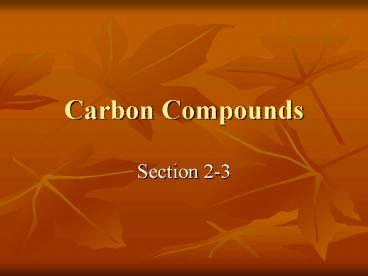Carbon Compounds - PowerPoint PPT Presentation
1 / 28
Title:
Carbon Compounds
Description:
Carbon can form single, double or triple bonds. Carbon forms important ... Carbo = carbon, hydrate = water; carbohydrates have the molecular formula (CH2O)n ... – PowerPoint PPT presentation
Number of Views:131
Avg rating:3.0/5.0
Title: Carbon Compounds
1
Carbon Compounds
- Section 2-3
2
Organic Molecules
- Molecules containing 2 or more atoms of carbon
- Carbon is very versatile
- Carbon covalently bonds with up to 4 other atoms
- Carbon can bond with carbon to
- form
- Chains
- Branches
- Rings
3
Organic Molecules
- Carbon can form single, double or triple bonds
- Carbon forms important biological molecules
4
Macromolecules giant molecules
- There are four classes of organic (carbon based)
macromolecules - Carbohydrates
- Lipids
- Proteins
- Nucleic Acids
5
Macromolecules are polymers
- What is a polymer?
- Poly many mer part. A polymer is a large
molecule consisting of many smaller sub-units
(monomers) bonded together. - What is a monomer?
- A monomer is a sub-unit of a polymer
- Three of the organic macromolecules are polymers
6
1. Carbohydrates
- Carbo carbon, hydrate water carbohydrates
have the molecular formula (CH2O)n - 121 ratio
- Common types
- Sugar
- Starch
7
Carbohydrates
- Functions
- Store chemical energy for cellular use
- Structural support in cells
- E.g. cellulose cell wall in plants
8
Monosaccharides
- Monosaccharide monomer of 3-7 carbons
- E.g. glucose, galactose, fructose
9
Disaccharides
- Disaccharide - two monos linked
- Lactose glucose galactose
Sucrose glucose fructose
10
Polysaccharides
- Polysaccharides Many monos linked
- E.g. starch
11
2. Lipids
- Generally hydrocarbons (made of hydrogen and
carbon) - Not a polymer
- Not water soluble
12
Lipids
- Examples
- Fats
- Oils
- Waxes
- Steroids
13
Lipids
- Functions
- Energy storage long term
- Membrane structure
- Waterproofing
- Insulation
- Shock absorbing
- Chemical messengers (hormone action)
14
Lipids
- Are made of two parts
- 1 Glycerol 3 fatty acids
15
Fatty Acids Saturated or Unsaturated
- 1. Saturated fats saturated with hydrogen
- have only single C-C bonds
- solid at room temp
- most animal fats
- 2. Unsaturated fats
- liquid at room temp
- double bonds between carbonsallows for kinks
in the tails - most plant fats
- 3. Polyunsaturated many double bonds
16
Which type of fatty acid is this?
17
Which type of fatty acid is this?
Saturated fatty acid
18
Good Job!!
Saturated fatty acid
Unsaturated fatty acid
19
3. Nucleic Acid
- Made of elements carbon, hydrogen, oxygen,
nitrogen and phosphorus (CHONP) - Polymers of nucleotides
Nucleotide
20
Nucleotide
- Composed of
- a. 5-Carbon sugar
- b. Phosphate group
- c. Nitrogen base
21
(No Transcript)
22
Nucleic Acids
- Two kinds
- DNA
- Double stranded
- Sugar deoxyribose
- Contains genes which code for proteins
- Contains hereditary information
- RNA
- Single stranded
- Sugar ribose
- Functions in synthesis of proteins coded for by
DNA
RNA
DNA
23
4. Protein
- Polymer of amino acids
- Made of elements carbon, hydrogen, oxygen and
nitrogen (CHON) - Amino acids held together with peptide bonds
- Proteins called polypeptides
24
Structure of Amino Acid Monomers
- Carbon covalently bonded to
- Hydrogen
- Amino group (NH3)
- Carboxyl group (COOH)
- Variable R group specific to each amino acid
25
Types of Amino Acids
- 20 common amino acids (determined by the R
group)
26
Peptide Bonding
- A peptide bond holds one amino acid to the next
27
Protein functions
- Enzymes accelerate chemical reactions
- Structural - Example
- keratin (the protein found in hair and nails)
- collagen (the protein found in connective tissue)
- Cell identity
- Membrane transport
- Cell movement
28
Shape important to Protein Function
- Changing shape changes function
- 4 levels of shape
- Primary
- Secondary
- Tertiary
- Quaternary
29
(No Transcript)































